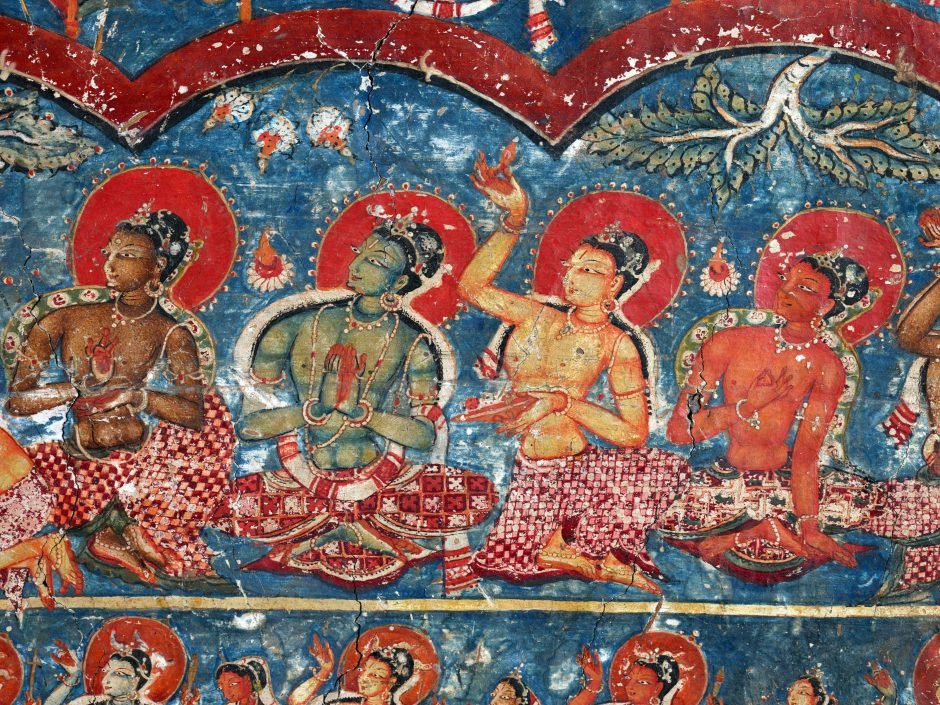The Sangha Jewel
by Jon Aaron and Upayadhi
The Buddha’s cousin and attendant Ananda went to the Blessed One and, on arrival, having bowed down to the Blessed One, sat to one side. As he was sitting there, Ven. Ananda said to the Blessed One, "This is half of the holy life, lord: admirable friendship, admirable companionship, admirable camaraderie." "Don't say that, Ananda. Don't say that. Admirable friendship, admirable companionship, admirable camaraderie is actually the whole of the holy life. (from the Uppadha Sutta)
The Buddha and Ananda, painting by Isha.
The “Sangha,” in the narrow sense, usually represents the community of mendicants who followed the historical Buddha. And in Asia today, when you hear the word sangha, it usually references those who are fully ordained. When we talk about the Sangha Jewel as Refuge in the Buddhist tradition, technically this is even more narrow. It actually means the Arya Sangha, that is to say the community of people who are fully awakened, like the Buddha. This is what we can place our heart upon and fully trust. And the tradition is incredibly optimistic: we can all become Buddhas!... When we take refuge in the Sangha we can recollect this historical community around the Buddha, and all the fully awakened beings through the ages. This also represents the continuation of the Buddha’s teachings as passed forward from generation to generation. We can envision these generations as our spiritual ancestors who, in a sense, “have our backs”. There would be no living Dharma without them. And there would be no living Buddhas or Buddhas-to-be without their efforts to transmit the practices.
When the going gets rough in community life, and people and groups let us down as they inevitably will at some point, it can be important to remember the narrow meaning of the Sangha Jewel. We can’t really reliably go for refuge to unawakened beings and groups. If we start to relate to them with the expectation of always finding perfect refuge, we will likely set ourselves up for a lot of disappointment.
Yet, sangha can also be understood as a verb, as a practice, and the ineffable space between us that is neither you nor me. We can relate to our actual communities of practice as places where we can get serious glimpses of true refuge.
Those of us who have been practicing for a long time often have many sanghas with a small “s.” Sometimes they last only as long as the retreat. Depending on the nature of the retreat, communities may form which sustain themselves far longer than a retreat. There are also sanghas which form as a result of studying together over a number of months. Those who have participated in a Dharma class or a Mindfulness Based Stress Reduction class may have had this experience. And of course there are also sanghas which are rooted in a particular lineage or an amalgamation of several lineages, and which function more like a “congregation,” evolving simply from the regularity of practicing together through all of life’s stages and events, day after day, week after week, year after year.
This is certainly the case with the Space 2 Meditate sangha. Even though we rarely see each other in 3D, the fact that we practice together six mornings a week, many of us for over two years now, creates a particular sense of connection and sometimes relief and comfort. We don’t communicate in the “normal” way and yet communication is happening. This is the power of sangha with a small “s.”
Detail from a temple painting in Alchi, in the Himalayas. Photo by Peter van Ham.
As long as we remember that our sanghas with a small “s” are also impermanent, empty of their own essence, and unreliable (these are the “three Marks of Existence”), then we can joyfully engage and contribute. If our communities were perfect, there would be nothing to practice with. The practice of sangha is learning how to work with challenges when they arise, together. This can involve brave and vulnerable communication, and the ability to apologize and forgive.
Can we be angry and compassionate at the same time? Can we be annoyed with someone and yet show friendship? As we tussle with these kinds of questions, we might begin to understand why the Buddha stated that admirable friendship is the whole of spiritual life. Our motley crew communities are our training ground. Sometimes a cremation ground and sometimes a Buddhafield!
Spiritual friendship requires presence and compassion, sometimes fierce compassion! We listen to and are listened to by our spiritual friends without judgment. We offer feedback only when requested and always from a place of love and care. We stand firmly in our practice to support others in theirs and vice versa. We taste liberation together, and our inextricable interrelatedness. Sangha and spiritual friendship create the conditions for “I-ness” to fall away. That is sometimes beautiful and sometimes messy.
And in those moments of magic between us, we are somehow connected to the motley crew of mendicants who set out with the Buddha to fully awaken, back in the day. It was also messy and hard and beautiful all at once. We can rejoice in the historical Sangha, the Aryasangha and all the sanghas with a small “s.”. We are connected to a river of practice that runs through time and space right to us, right now, right here. This great river includes countless beings who have touched true lasting freedom and shared this with others, keeping the river flowing.
May we all receive the blessings of the ancestors, may we all find refuge in communities of now, may we all receive and pass on spiritual friendship.


